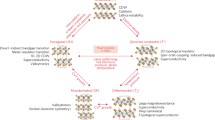Abstract
Layered crystalline materials like K3Me(CN)6 with Me=Cr, Mn, Fe, Co may often exist in various polytypic forms, due to a variety of choices of layer stacking modes. For cases where the interlayer constellations can be limited to only two energetically almost equivalent ways, the buildup of the crystal may be described by a spin-1/2 Ising-like model. For the system presently being studied one can rationalize the layer stacking to a four-valued choice (i.e., a 1D 4-state Potts case), or use an Ising-like two-sublattice model. Previous diffraction studies of K3Me(CN)6 indicated that two long-range ordered structures prevailed, an orthohombic one named MDO1, with one double layer per repetition unit, and a monoclinic one, MDO2, with two double-layer units. Our studies reveal a more complex situation: The Fe material is for the most part of the MDO2 type. But in addition, in some crystal samples, a hitherto unobserved phase also appears, with six double-layer repetition units, in fact a hybrid of MDO1 and MDO2. The Co material is for the most part of the MDO2 type, but contains in addition a considerable contribution of stacking disorder, as evidenced by the presence of diffuse X-ray scattering lines. The lines do, however, contain distinct maxima, indicating the presence of several layer stacking modes with preference of two, three, four, five, and seven double-layer correlations. The findings can be qualitatively discussed in terms of the ANNNI model.
Similar content being viewed by others
References
A. R. Verma and P. Krishna,Polymorphism and Polytypism in Crystals (Wiley, New York, 1966).
G. D. Price, and J. Yeomans,Acta Cryst. B 40:448 (1984).
G. D. Price, S. C. Parker, and J. Yeomans,Acta Cryst. B 41:231 (1985).
R. J. Angel, G. D. Price, and J. Yeomans,Acta Cryst. B 41:310 (1985).
E. J. Samuelsen,Phys. Rev. Lett. 31:936 (1973);J. Phys. Chem. Solids. 35:785 (1974).
N.-G. Vannerberg,Acta Chem. Scand. 24:2335 (1970).
N.-G. Vannerberg,Acta Chem. Scand. 26:2863 (1972).
S. Jagner, E. Ljungström, and N.-G. Vannerberg,Acta Chem. Scand. A 28:623 (1974).
K. Dornberger-Schiff,Lehrgang über O-D-Strukturen (Akademie, Berlin, 1966).
R. J. Elliot,Phys. Rev. 124:346 (1961).
P. Bak,Rep. Prog. Phys. 45:587 (1982).
F. Y. Wu,Rev. Mod. Phys. 54:235 (1982).
E. J. Samuelsen, S. Tjøtta, and S. Jagner,J. Phys. Condensed Matter 3:3421 (1991).
T. R. Welberry,Rep. Prog. Phys. 48:1543 (1985).
Author information
Authors and Affiliations
Rights and permissions
About this article
Cite this article
Samuelsen, E.J., Tuset, E.D., Ausen, D. et al. Stacking order and disorder in layered K3Me(CN)6 compounds studied by diffuse X-ray scattering: A realization of the ANNNI model?. J Stat Phys 78, 135–145 (1995). https://doi.org/10.1007/BF02183342
Received:
Accepted:
Issue Date:
DOI: https://doi.org/10.1007/BF02183342




